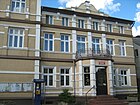Gościno
Gościno | |
|---|---|
Town | |
 Karlińska Street | |
| Coordinates: 54°3′13″N 15°39′2″E / 54.05361°N 15.65056°E | |
| Country | |
| Voivodeship | West Pomeranian |
| County | Kołobrzeg |
| Gmina | Gościno |
| First mentioned | 13th century |
| Town rights | 2011 |
| Population | 2,332 |
| Time zone | UTC+1 (CET) |
| • Summer (DST) | UTC+2 (CEST) |
| Postal code | 78-120 |
| Area code | +48 94 |
| Car plates | ZKL |
| Voivodeship roads | |
Gościno (Polish: [ɡɔɕˈt͡ɕinɔ]; Kashubian: Gòscëno; German: Groß Jestin)[1] is a small town in Kołobrzeg County, West Pomeranian Voivodeship, in north-western Poland. It is the seat of the gmina (administrative district) called Gmina Gościno.[2] It lies in Pomerania, approximately 14 kilometres (9 mi) south-east of Kołobrzeg and 100 km (62 mi) north-east of the regional capital Szczecin.
The town has a population of 2,332.
History
[edit]
The territory became part of the emerging Polish state under its first ruler Mieszko I around 967.[3] The earliest documentation of the village of Gościno appears in the year 1238 as a property of the Knights of St. John of Jerusalem. The town's name derives from the Old Polish male name Gościmir.[4] A main tourist site in Gościno, the Church of St. Andrew Bobola, houses a cup-shaped baptismal font hewn from one Gotland limestone boulder, from the 12th and 13th centuries. It is one of the few sacred relics of this kind in Western Pomerania.[5]
During earlier centuries the settlement had been a domain owned and farmed out by the town of Kołobrzeg.[citation needed] It had been bought by the town's magistrate in the 14th century from the abbot of Doberan Abbey. Around 1780 the domain included 16 farm houses.[citation needed]
From the 18th century the village was part of the Kingdom of Prussia and from 1871 to 1945 it was also part of Germany, administratively located in the Landkreis Kolberg-Körlin of the Province of Pomerania. During World War II, in February 1945, a German-perpetrated death march of Allied prisoners-of-war from the Stalag XX-B POW camp passed through the town.[6] After the defeat of Nazi Germany in the war in 1945 the area became again part of Poland.
Since 1 January 2011 Gościno has had the status of a town.
Gallery
[edit]-
IV Dywizji Wojska Polskiego Street
-
Public library
-
Memorial stone
-
Old house
Notable people
[edit]- Egon Schultz (1943–1964) a German sergeant of the East German Border Troops who became the fifty-second known person to die at the Berlin Wall
See also
[edit]References
[edit]- ^ M. Kaemmerer (2004). Ortsnamenverzeichnis der Ortschaften jenseits von Oder u. Neiße (in German). ISBN 3-7921-0368-0.
- ^ "Central Statistical Office (GUS) - TERYT (National Register of Territorial Land Apportionment Journal)" (in Polish). 2008-06-01.
- ^ Labuda, Gerard (1993). "Chrystianizacja Pomorza (X–XIII stulecie)". Studia Gdańskie (in Polish). Vol. IX. Gdańsk-Oliwa. p. 47.
- ^ Edward Breza, Zeszyty Kulickie, 1999, p. 96 (in Polish)
- ^ Strona główna - Parsęta
- ^ Kaszuba, Sylwia. "Marsz 1945". In Grudziecka, Beata (ed.). Stalag XX B: historia nieopowiedziana (in Polish). Malbork: Muzeum Miasta Malborka. pp. 102, 109. ISBN 978-83-950992-2-9.
External links
[edit]- Website of Gmina Gościno (BIP) (Polish)







